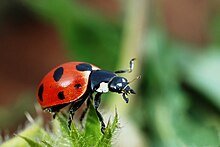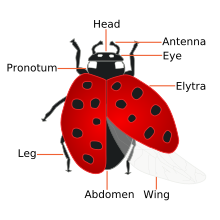Eskiden önlükler vardı
Önceleri siyah
Sonra mavi...
25 Eylül 2016 Pazar
22 Eylül 2016 Perşembe
13 Eylül 2016 Salı
Coccinellidae
From Wikipedia, the free encyclopedia
(Redirected from Ladybug)
"Ladybird", "Ladybug", and "Lady beetle" redirect here. For other uses, see Ladybird (disambiguation).
| Ladybug | |
|---|---|
 |
|
| Coccinella magnifica | |
| Scientific classification | |
| Domain: | Eukarya |
| Kingdom: | Animalia |
| Phylum: | Arthropoda |
| Class: | Insecta |
| Order: | Coleoptera |
| Suborder: | Polyphaga |
| Superfamily: | Cucujoidea |
| Family: | Coccinellidae Latreille, 1807 [1] |
| Subfamilies [1] | |
|
|
They are commonly yellow, orange, or red with small black spots on their wing covers, with black legs, heads and antennae. However such colour patterns vary greatly. For example, a minority of species, such as Vibidia duodecimguttata, a twelve-spotted species, have whitish spots on a brown background. Coccinellids are found worldwide, with over 6,000 species described.[5][6]
Coccinellids are known as ladybugs in North America, and ladybirds in other areas. Entomologists widely prefer the names ladybird beetles or lady beetles as these insects are not classified as true bugs.[7]
The majority of coccinellid species are generally considered useful insects, because many species prey on herbivorous homopterans such as aphids or scale insects, which are agricultural pests. Many coccinellids lay their eggs directly in aphid and scale insect colonies in order to ensure their larvae have an immediate food source.[8] However, some species do have unwelcome effects; among these, the most prominent are of the subfamily Epilachninae, which are herbivorous themselves. Usually, epilachnines are only mild agricultural pests, eating the leaves of grain, potatoes, beans, and various other crops, but their numbers can increase explosively in years when their natural enemies, such as parasitoid wasps that attack their eggs, are few. In such situations, they can do major crop damage. They occur in practically all the major crop-producing regions of temperate and tropical countries.
Contents
Etymology
The name coccinellids is derived from the Latin word coccineus meaning "scarlet".[9] The name "ladybird" originated in Britain where the insects became known as "Our Lady's bird" or the Lady beetle.[10][11] Mary (Our Lady) was often depicted wearing a red cloak in early paintings, and the spots of the seven-spot ladybird (the most common in Europe) were said to symbolise her seven joys and seven sorrows.[10] In the United States, the name was adapted to "ladybug". Common names in other European languages have the same association, for example, the German name Marienkäfer translates to Marybeetle.[12]Physical appearance
Most coccinellids have oval, dome-shaped bodies with six short legs. Depending on the species, they can have spots, stripes, or no markings at all. Seven-spotted coccinellids are red or orange with three spots on each side and one in the middle; they have a black head with white patches on each side.As well as the usual yellow and deep red colourings, many coccinellid species are mostly, or entirely, black, dark grey, gray, or brown, and may be difficult for an entomologist/nonentomologists to recognise as coccinellids at all. Conversely, non-entomologists might easily mistake many other small beetles for coccinellids. For example, the tortoise beetles, like the ladybird beetles, look similar because they are shaped so that they can cling to a flat surface so closely that ants and many other enemies cannot grip them.
Non-entomologists are prone to misidentify a wide variety of beetle species in other families as "ladybirds", i.e. coccinellids. Beetles are particularly prone to such misidentification if they are spotted in red, orange or yellow and black. Examples include the much larger scarabaeid grapevine beetles and spotted species of the Chrysomelidae, Melyridae and others. Conversely, laymen may fail to identify unmarked species of Coccinellidae as "ladybirds". Other beetles that have a defensive hemispherical shape, like that of the Coccinellidae (for example the Cassidinae), also are often taken for ladybirds.
A common myth, totally unfounded, is that the number of spots on the insect's back indicates its age.[13][14] In fact, the underlying pattern and colouration are determined by the species and genetics of the beetle, and develop as the insect matures. In some species its appearance is fixed by the time it emerges from its pupa, though in most it may take some days for the colour of the adult beetle to mature and stabilise. Generally, the mature colour tends to be fuller and darker than the colour of the callow.
Biology
See also: List of Coccinellidae genera
Basic anatomy of a ladybird
Various larger species of Coccinellidae attack caterpillars and other beetle larvae.[15] Several genera feed on various insects or their eggs; for example, Coleomegilla species are significant predators of the eggs and larvae of moths such as species of Spodoptera and the Plutellidae.[16] Larvae and eggs of ladybirds, either their own or of other species, can also be important food resources when alternative prey are scarce. As a family, the Coccinellidae used to be regarded as purely carnivorous,[17] but they are now known to be far more omnivorous than previously thought, both as a family and in individual species; examination of gut contents of apparently specialist predators commonly yield residues of pollen and other plant materials. Besides the prey they favour, most predatory coccinellids include other items in their diets, including honeydew, pollen, plant sap, nectar, and various fungi. The significance of such nonprey items in their diets is still under investigation and discussion.[18]
Apart from the generalist aphid and scale predators and incidental substances of botanical origin, many Coccinellidae do favour or even specialise in certain prey types. This makes some of them particularly valuable as agents in biological control programmes. Determination of specialisation need not be a trivial matter, though; for example the larva of the Vedalia ladybird Rodolia cardinalis is a specialist predator on a few species of Monophlebidae, in particular Icerya purchasi, which is the most notorious of the cottony cushion scale species. However, the adult R. cardinalis can subsist for some months on a wider range of insects plus some nectar.[19]
Certain species of coccinellids are thought to lay extra infertile eggs with the fertile eggs, apparently to provide a backup food source for the larvae when they hatch. The ratio of infertile to fertile eggs increases with scarcity of food at the time of egg laying. Such a strategy amounts to the production of trophic eggs.[20]
Some species in the subfamily Epilachninae are herbivores, and can be very destructive agricultural pests (e.g., the Mexican bean beetle). Again, in the subfamily Coccinellinae, members of the tribe Halyziini and the genus Tythaspis are mycophagous.
While predatory species are often used as biological control agents, introduced species of coccinellids are not necessarily benign. Species such as Harmonia axyridis or Coccinella septempunctata in North America outcompete and displace native coccinellids and become pests themselves.[21]
The main predators of coccinellids are usually birds, but they are also the prey of frogs, wasps, spiders, and dragonflies. The bright colours of many coccinellids discourage some potential predators from making a meal of them. This phenomenon, called aposematism, works because predators learn by experience to associate certain prey phenotypes with a bad taste. A further defence, known as "reflex bleeding", exists in which an alkaloid toxin is exuded through the joints of the exoskeleton, triggered by mechanical stimulation (such as by predator attack) in both larval and adult beetles, deterring feeding.
Coccinellids in temperate regions enter diapause during the winter, so they often are among the first insects to appear in the spring. Some species (e.g., Hippodamia convergens) gather into groups and move to higher elevations, such as a mountain, to enter diapause.
Most coccinellids overwinter as adults, aggregating on the south sides of large objects such as trees or houses during the winter months, dispersing in response to increasing day length in the spring.[22]
Predatory coccinellids are usually found on plants which harbour their prey. They lay their eggs near their prey, to increase the likelihood the larvae will find the prey easily. In Harmonia axyridis, eggs hatch in three to four days from clutches numbering from a few to several dozen. Depending on resource availability, the larvae pass through four instars over 10–14 days, after which pupation occurs. After a teneral period of several days, the adults become reproductively active and are able to reproduce again, although they may become reproductively quiescent if eclosing late in the season. Total life span is one to two years on average.
Infestations and impacts
Coccinellids covering a branch
After an abnormally long period of hot, dry weather in the summer of 1976 in the UK, a marked increase in the aphid population was followed by a "plague" of ladybirds, with many reports of people being bitten as the supply of aphids dwindled.[24][25]
The presence of coccinellids in grape harvests can cause ladybird taint in wines produced from the grapes.[26]
As an alien species
Harmonia axyridis (the harlequin ladybird) is an example of how an animal might be partly welcome and partly harmful. It was introduced into North America from Asia in 1916 to control aphids, but is now the most common species, outcompeting many of the native species.[27] It has since spread to much of western Europe, reaching the UK in 2004.[27][28] It has become something of a domestic and agricultural pest in some regions, and gives cause for ecological concern. It similarly has turned up in parts of Africa, where it has proved variously unwelcome, perhaps most prominently in vine-related crops.UK ladybird survey
Coccinella septempunctata pair mating. This seven-spotted species is by far the most common ladybird in Europe.
Kaydol:
Yorumlar (Atom)




